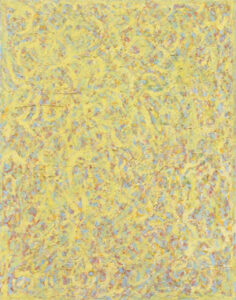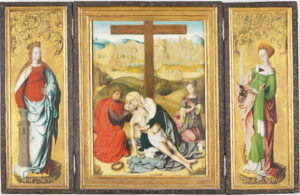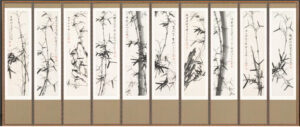Cleveland, September 21, 2022: Recent acquisitions by the Cleveland Museum of Art (CMA) include a masterpiece by Beauford Delaney, strengthening the museum’s collection of works by Black artists; a triptych by the Master of the Krainburg Altar, an outstanding example of panel painting around 1500; and an ink painting of bamboo by Korean artist Jin-woo Kim.
 Beauford Delaney’s Untitled
Beauford Delaney’s Untitled
The CMA’s abstract expressionist holdings are significantly enhanced with this newest acquisition
One of Beauford Delaney’s finest and most exuberant achievements, “Untitled” is a visually engaging, generously scaled composition featuring highly gestural and textured applications of paint. Its striking palette radiates with buoyant yellow interlaced throughout with prismatic blue and red, with intermittent complementary accents in green and orange. The predominant yellow brushwork is deployed in lively undulating arcs across the surface of the canvas, creating a cohesive allover arrangement. In style, the painting marks an important contribution to abstract expressionism, the mid-twentieth-century movement devoted to communicating psychological and emotional impulses through line, shape, color, and texture, most often without making reference to recognizable objects.
Delaney was so passionate about the aesthetic and symbolic possibilities of yellow that it became his “signature” hue; subsequently, his yellow abstractions have become his most desirable and sought-after works. For the artist, yellow connoted feelings of spiritual ecstasy and transcendence, and through its enthusiastic embrace he created painted equivalents to happiness and joy even when his personal circumstances were challenging, if not bleak.
Born in Jim Crow–era Knoxville, Tennessee, Delaney sought artistic training in Boston and settled in New York to launch his career. In 1953, he moved to Paris, hoping to mitigate the effects of the racist and homophobic strictures he encountered in America. There he joined a cadre of international artists, including a growing number of Black luminaries, among them James Baldwin, for whom he became both mentor and muse. Although Delaney created consistent, high-quality work, had gallery representation, exhibited on numerous occasions, and earned critical praise, financial success eluded him. At the time of his death, he was destitute.
Due to his race and sexual orientation, and despite his achievements, Delaney did not attain the level of fame necessary to guarantee him a place in the early histories of the abstract expressionist movement. However, interest in his work has been steadily increasing during the past quarter century.

Triptych with The Lamentation of Christ (center), Saint Barbara (left wing), Saint Catherine of Alexandria (right wing), The Annunciation (reverse wings)
Triptych datable about 1500 includes a topographically accurate representation of Jerusalem
This exquisite triptych shows, in the center, the Lamentation of Christ. On the wings, Saint Barbara appears on the left with her characteristic attribute, the tower, and on the right is Saint Catherine of Alexandria, recognizable by the sword she demonstratively raises with her right hand. On the back is an annunciation scene that, in style and quality, differs from the front.
The triptych was painted by the “Master of the Krainburg Altar,” named after the panel paintings from the parish church of the town of Krainburg / Kranj, Slovenia (held today in the Belvedere Palace in Vienna). Although only a few works attributed to the artist have survived, the anonymous master was one of the outstanding painters of the period around 1500, active in what is now Slovenia. Little is known about the artist––who has so far received little attention––but we can say that he must have known the works of Netherlandish artists such as Rogier van der Weyden and Petrus Christus.
The exact representation of the city of Jerusalem in the background is exceptional. The model for the cityscape is a woodcut by Erhard Reuwich for the publication Peregrinatio in Terram Sanctam (“Pilgrimage to the Holy Land”) by Bernhard von Breydenbach, published in 1486. A member of the clergy of Mainz Cathedral, Breydenbach made a pilgrimage to the Holy Land in 1483–84. His Peregrinatio was the first illustrated travel book, became a bestseller, and was reprinted thirteen times in the following three decades. While no clear dating exists for the triptych, it is known to have been created after 1486 because the artist knew this model.
 Bamboos in Wind
Bamboos in Wind
Early 20th-century Korean interpretation of bamboo celebrates an untold story of Korean art as a tool of empowerment
Across all ten panels of this folding screen, “Bamboos in Wind” depicts bamboo and its gestural movements blowing in the wind. While depicted from a variety of angles and perspectives, the bamboo is united by the dynamic brushstrokes with which it is described.
The inscription on the panel at the far left indicates that the artist Jin-woo Kim painted this work in 1934 at his studio, known as the “House of Bamboo Forest.” Jin-woo Kim was one of the most celebrated painters of early 20th-century Korea, highly praised for his renderings of extremely sharp bamboo, often compared to iron spears and knives. Deeply involved in many resistance efforts for Korea’s independence, the artist emphasized sharp edges through dynamic brushstrokes, suggesting his bamboos were weapons to challenge the oppression of Japanese colonial rule in Korea (1910–45).
In East Asian art, plum blossoms, orchids, bamboo, and chrysanthemums are known as the Four Gentlemen, symbolizing uprightness, purity, humility, and perseverance against harsh conditions. Bamboos in Wind joins Yi Ha-eung’s Orchid and Rock (John L. Severance Fund, 2015.138) in the CMA’s collection as works that represent the evolution of Four Gentlemen into a modernist idiom within the Korean art tradition.
About the Cleveland Museum of Art
The Cleveland Museum of Art is renowned for the quality and breadth of its collection, which includes more than 63,000 artworks and spans 6,000 years of achievement in the arts. The museum is a significant international forum for exhibitions, scholarship and performing arts and is a leader in digital innovations. One of the top comprehensive art museums in the nation, recognized for its award-winning Open Access program and free of charge to all, the Cleveland Museum of Art is located in the University Circle neighborhood.
The museum is supported in part by residents of Cuyahoga County through a public grant from Cuyahoga Arts & Culture and made possible in part by the Ohio Arts Council (OAC), which receives support from the State of Ohio and the National Endowment for the Arts. The OAC is a state agency that funds and supports quality arts experiences to strengthen Ohio communities culturally, educationally and economically. For more information about the museum and its holdings, programs and events, call 888-CMA-0033 or visit cma.org.

